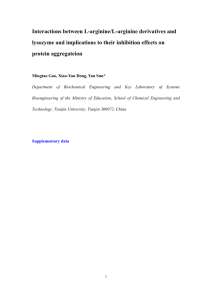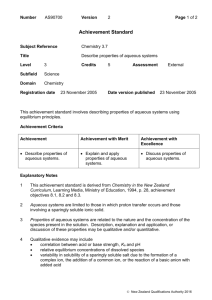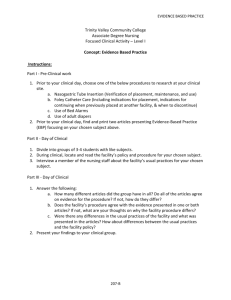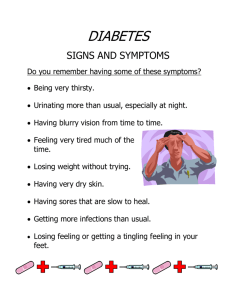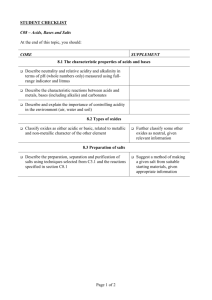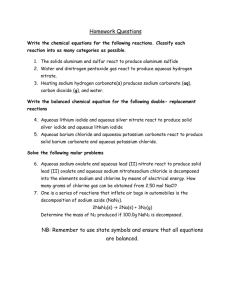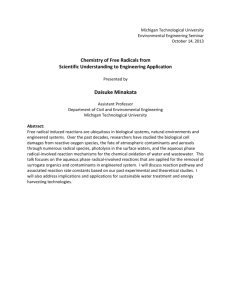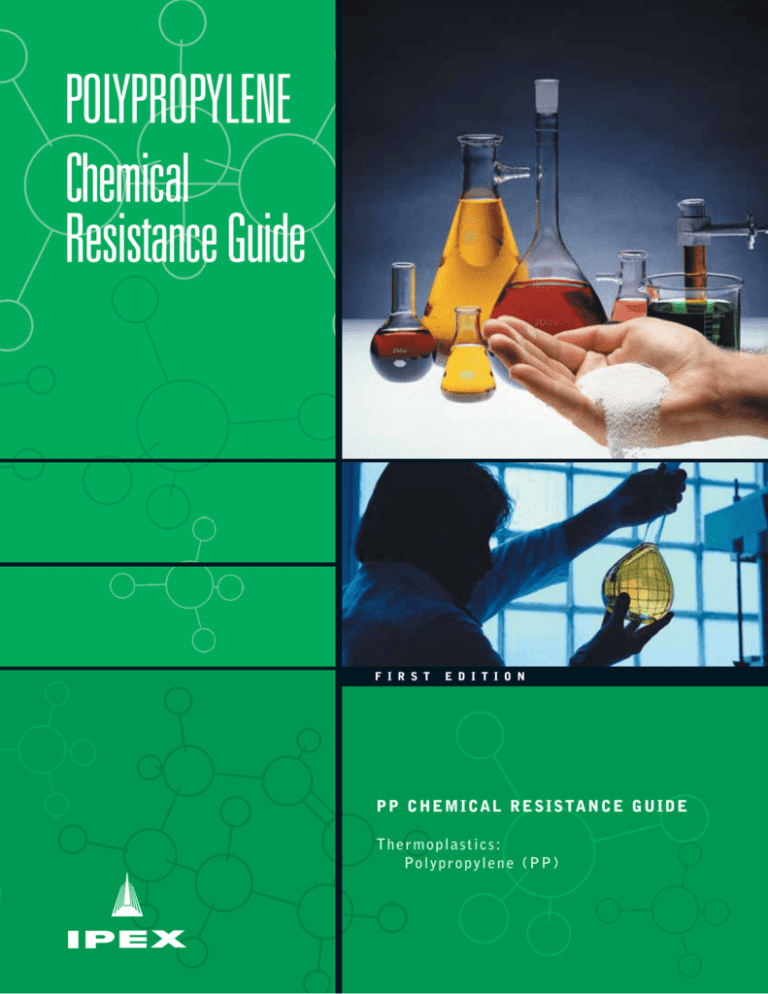
POLYPROPYLENE
Chemical
Resistance Guide
F I R S T
E D I T I O N
P P C H E M I CA L R E S I S TA N C E G U I D E
Thermoplastics:
Po l y p r o p y l e n e ( P P )
Chemical Resistance Guide
Polypropylene (PP)
1st Edition
© 2009 by IPEX. All rights reserved. No part of this book may
be used or reproduced in any manner whatsoever without prior
written permission. For information contact: IPEX, Marketing, 2441
Royal Windsor Drive, Mississauga, Ontario, Canada, L5J 4C7.
The information contained here within is based on current
information and product design at the time of publication and is
subject to change without notification. IPEX does not guarantee or
warranty the accuracy, suitability for particular applications, or
results to be obtained therefrom.
A BOUT IPEX
At IPEX, we have been manufacturing non-metallic pipe and fittings since 1951. We formulate our own compounds and
maintain strict quality control during production. Our products are made available for customers thanks to a network of
regional stocking locations from coast-to-coast. We offer a wide variety of systems including complete lines of piping, fittings,
valves and custom-fabricated items.
More importantly, we are committed to meeting our customers’ needs. As a leader in the plastic piping industry, IPEX
continually develops new products, modernizes manufacturing facilities and acquires innovative process technology. In addition,
our staff take pride in their work, making available to customers their extensive thermoplastic knowledge and field experience.
IPEX personnel are committed to improving the safety, reliability and performance of thermoplastic materials. We are involved in
several standards committees and are members of and/or comply with the organizations listed on this page.
For specific details about any IPEX product, contact our customer service department.
INTRODUCTION
Thermoplastics and elastomers have outstanding resistance to a wide range of chemical reagents. The chemical resistance of
plastic piping is basically a function of the thermoplastic material and the compounding components. In general, the less
compounding components used the better the chemical resistance. Thermoplastic pipes with significant filler percentages may
be susceptible to chemical attack where an unfilled material may be affected to a lesser degree or not at all.
Some newer piping products utilize a multi-layered (composite) construction, where both thermoplastic and non-thermoplastic
materials are used for the layers. Layered composite material pipe may have chemical resistance that differs from the
chemical resistance of the individual material. Such resistance however, is a function both of temperatures and concentration,
and there are many reagents which can be handled for limited temperature ranges and concentrations. In borderline cases, it
will be found that there is limited attack, generally resulting in some swelling due to absorption. There are also many cases
where some attack will occur under specific conditions, but for many such applications, the use of plastic will be justified on
economic grounds when considered against alternative materials. Resistance is often affected (and frequently reduced) when
handling a number of chemicals or compounds containing impurities. For this reason, when specific applications are being
considered, it may be worthwhile to carry out tests using the actual product that will be encountered in service. The listing
that follows does not address chemical combinations.
The information is based on immersion tests on unstressed coupons, experiments and, when available, actual process
experience as well as data from tests inclusive of stress from temperature and pressure. The end user should be aware of the
fact that actual service conditions will affect the chemical resistance.
Chemicals that do not normally affect the properties of an unstressed thermoplastic may cause completely different behavior
(such as stress cracking) when under thermal or mechanical stress (such as constant internal pressure or frequent thermal or
mechanical stress cycles). Chemical resistance data from immersion tests cannot be unconditionally applied to thermoplastic
piping components subjected to continuous or frequent mechanical or thermal stresses.
When the pipe will be subject to a continuous applied mechanical or thermal stress, or to combinations of chemicals, testing
that duplicates the expected field conditions, as closely as possible, should be performed on representative samples of the
pipe product to properly evaluate plastic pipe for use in this application.
RATINGS
Ratings are according to the product and suppliers.
The absence of any class indication for any given materials, signifies the absence of data for such material(s) with respect to
the specific chemical(s), temperature(s) and concentration(s).
Note: Chemical resistance data is found in a laboratory setting and cannot account for all possible variables of an installed
application. It is up to the design engineer or final user to use this information as guidance for a specific application design.
If a material is chemically resistant to the concentrated form of a specific chemical, it should be resistant to the diluted form
of that same chemical.
All Chemical Resistance data for Polypropylene (PP) contained within this manual has been provided, with written
consent, by Durapipe.
IPEX Chemical Resistance Guide for PP
i
NOTES
______________________________________________________
______________________________________________________
______________________________________________________
______________________________________________________
______________________________________________________
______________________________________________________
______________________________________________________
______________________________________________________
______________________________________________________
______________________________________________________
______________________________________________________
______________________________________________________
______________________________________________________
______________________________________________________
______________________________________________________
______________________________________________________
______________________________________________________
______________________________________________________
______________________________________________________
______________________________________________________
______________________________________________________
______________________________________________________
______________________________________________________
______________________________________________________
______________________________________________________
______________________________________________________
______________________________________________________
______________________________________________________
______________________________________________________
______________________________________________________
______________________________________________________
______________________________________________________
ii
IPEX Chemical Resistance Guide for PP
POLYPROPYLENE (PP)
All Chemical Resistance data for Polypropylene (PP) contained within this manual has been provided, with written
consent, by Durapipe.
Material:
•
Polypropylene (PP)
Chemical Resistance and Performance Data:
•
Strong mineral acids
•
Caustic and ammoniacal solutions
•
Inorganic salt solutions
•
Many organics
•
Detergents
•
Temperature range: 32ºF to 212ºF (0ºC to +100ºC)
Thermoplastic Pipe - Guidance for Correct Usage:
Chemical resistance is affected by the following factors:
•
temperature
•
fluid concentration
•
aeration
•
flow velocity
•
turbulence
•
duration of exposure
•
pressure
Fire:
Typical Applications:
•
Hot chemical applications
•
Acid waste drainage
Unsuitable for Following Uses:
•
Strong oxidizing acids and halogens
* Note, temperatures given are for guidance only; please
check before specifying
The use of thermoplastic material to convey flammable
substances may be unacceptable due to fire hazard.
Foodstuffs:
A resistant classification does not imply absolute
suitability (e.g. certain foodstuffs may require gaskets to
meet organoleptic requirements).
Thread Sealants:
Some adhesive thread sealants can chemically attack
some plastics and must not be used.
Please refer to Volume III: Acid Waste Piping Systems
Technical Manual for further details.
Label Adhesive:
It is possible that label adhesives will contain stress
cracking agents.
We recommend that other methods are used to mark
pipe or that adequate checks are made to ensure
suitability.
IPEX Chemical Resistance Guide for PP
1
POLYPROPYLENE (PP)
These notes are to be read in conjunction with the
Chemical Resistance tables:
1.
See under Allyl, Amyl, Butyl, Ethyl, Furfuryl, Methyl,
or iso-Propyl
2.
These are compounds whose general formula is either
(R1)2SO4(R2)2(SO4)6.24 H2O or (R1)(R2)(SO4)2. 12 H2O,
where R1 represents an atom of Potassium, Sodium,
Ammonium, Rubidium, Caesium, Silver, or Thallium;
and R2 represents an atom of Aluminium, Iron,
Chromium, Manganese or Thallium.
18. Some of this group of chemicals could be very
aggressive towards plastics and rubbers, but others
would be quite harmless. Refer to IPEX for a
specific recommendation.
19. See under either Ferrous or Ferric.
3.
This substance is insoluble in pure water. If
conveyed aqueous it would always be in the form of
a suspension.
4.
This substance decomposes in hot water. Unless
suitability is indicated refer to IPEX.
5.
Substances which are generally categorised can have
widely variable compositions, and therefore each
needs to be tested for suitability. Refer to IPEX.
6.
This substance is only sparingly soluble in water. If
conveyed aqueous it would usually be in the form of
a suspension.
7.
Solutions other than sea water and aqueous Sodium
chloride should be referred to IPEX for suitability
tests.
8.
This substance is sparingly soluble in water, which
then reacts with it.
9.
A solution of Chromium trioxide in water, often
produced by the action of concentrated Sulphuric
acid on Sodium dichromate.
10. This substance is explosive and would not normally
be considered suitable for conveyance in plastic
pipework.
11. Oils can contain variable amounts of aromatic
hydrocarbons and additives. Refer to IPEX for a
specific recommendation.
12. Most plasticizers are not suitable for conveyance in
plastics.
13. Not for conveyance in the presence of Bromide.
14. Not for conveyance in the presence of Bromate.
15. Not for conveyance in the presence of lodide.
16. Not for conveyance in the presence of lodate.
17. The substance decomposes in cold water. Unless
suitability is indicated, refer to IPEX.
2
IPEX Chemical Resistance Guide for PP
Classification
+
Resistant
*
Likely to be resistant
O
Unlikely to be resistant
–
Not resistant
blank
No data available
In some instances an asterix (*) has been used where
extensive usage by IPEX customers indicates suitability, but
where confirmation by in-house testing is not possible.
Where data is not currently available, but where samples can
be supplied by potential customers, IPEX will then conduct
chemical suitability tests and make recommendations
accordingly.
POLYPROPYLENE (PP)
CHEMICAL RESISTANCE DATA
Chemical & Concentration
Usage
20ºC
(68ºF)
40ºC
(104ºF)
60ºC
(140ºF)
80ºC
(176ºF)
100ºC
(212ºF)
O
O
O
O
O
O
A
Acetaldehyde
Usual technical
Acetamide 5%
Aqueous
Acetic acid 10%
Aqueous
+
+
Acetic acid 50%
Aqueous
+
+
Acetic acid 80%
Aqueous
+
+
Acetic acid glacial
Usual technical
+
+
Acetic anhydride
Usual technical
*
Acetone
Usual technical
+
Acetophenone
Usual technical
+
Acetyl chloride
Usual technical
Acrylonitrile
Usual technical
Adipic acid
Saturated aqueous
Alcohol
Usual technical
(see note 1)
+
+
*
*
*
*
*
*
Allyl alcohol
Usual technical
*
*
*
Allyl chloride
Usual technical
O
O
O
O
Alum (s)
Saturated aqueous
+
+
+
+
Aluminium chloride
Saturated aqueous
+
+
+
+
Aluminium fluoride
Saturated aqueous
+
+
+
Suspended aqueous
+
+
+
Saturated aqueous
+
+
+
Suspended aqueous
+
+
+
(see note 2)
Aluminium hydroxide
(see note 3)
Aluminium nitrate
Aluminium oxalate
(see note 3)
Aluminium sulphate
Saturated aqueous
+
+
+
Ammonia 35% Sp. gr. = 0.88
Aqueous
+
+
+
Ammonia dry gas
Usual commercial
+
+
+
Ammonia liquid
Usual commercial
+
+
Ammonium carbonate
(see note 4)
Saturated aqueous
+
+
Ammonium chloride
(see note 4)
Saturated aqueous
+
Ammonium fluoride
(see note 4)
Saturated aqueous
+
Ammonium hydroxide Sp. gr. = 0.88
Aqueous
*
Saturated aqueous
*
*
*
Ammonium molybdate
Ammonium nitrate
Saturated aqueous
+
+
+
Ammonium persulphate
Saturated aqueous
+
+
+
Ammonium phosphate(s)
Saturated aqueous
+
+
+
Ammonium sulphate
Saturated aqueous
+
+
+
Ammonium thiocyanate
Saturated aqueous
O
O
O
O
O
n-Amyl acetate
Usual technical
O
O
O
O
O
n-Amyl alcohol
Usual technical
+
+
+
Aniline
Usual technical
+
Animal glue, oils
+ Resistant
*
(see note 5)
Likely to be Resistant
Usual commercial
O Unlikely to be Resistant
– Not Resistant
(Blank) No data available
IPEX Chemical Resistance Guide for PP
3
POLYPROPYLENE (PP)
CHEMICAL RESISTANCE DATA
Chemical & Concentration
Usage
Antifreeze
Usual proprietary
(see note 5)
20ºC
(68ºF)
40ºC
(104ºF)
60ºC
(140ºF)
80ºC
(176ºF)
Antimony trichloride
Saturated aqueous
+
+
+
Aqua regia
Usual technical
–
–
–
–
Aromatic hydrocarbons
Various blends
–
–
–
–
Saturated aqueous
+
+
+
+
Saturated aqueous
+
+
+
+
100ºC
(212ºF)
–
B
Barium bromide
Barium carbonate
(see note 6)
Barium chloride
Saturated aqueous
+
+
+
+
Barium hydroxide
Saturated aqueous
+
+
+
+
+
Barium sulphate
Saturated aqueous
+
+
+
Battery acid Sp. gr. = 1.18
Aqueous
+
+
+
Beer
Usual commercial
+
Benzaldehyde
Usual technical
*
Benzene
Usual technical
–
–
–
–
Benzoyl chloride
Usual technical
O
O
O
O
Benzyl chloride
Usual technical
O
O
O
O
Borax
Saturated aqueous
+
+
+
+
Saturated aqueous
+
+
+
+
Usual proprietary
+
+
+
+
Bromine
Anhydrous liquid
–
–
–
–
–
Bromine water
Saturated aqueous
–
–
–
–
–
Bromine, trace levels
Aqueous, for sterilization
+
Butane
Gaseous
2-Butoxyethanol
Usual technical
Buttermilk
Usual commercial
+
n-Butyl acetate
Usual technical
O
O
–
–
n-Butyl alcohol
Usual technical
+
*
*
n-Butyric acid
Usual technical
Suspended aqueous
+
+
+
+
Saturated aqueous
+
+
+
+
Saturated aqueous
+
+
+
+
(see note 6)
Boric acid
Brake fluids
Brine
(see note 5)
(see note 7)
–
Usual proprietary
C
Cab O-Sil
(see note 3)
Calcium bromide
Calcium carbonate
(see note 6)
Calcium chloride
Calcium hydroxide
(see note 6)
Calcium nitrate
+ Resistant
4
*
Likely to be Resistant
IPEX Chemical Resistance Guide for PP
Saturated aqueous
+
+
+
+
Usual industrial
+
+
+
+
Saturated aqueous
+
+
+
+
O Unlikely to be Resistant
– Not Resistant
(Blank) No data available
POLYPROPYLENE (PP)
CHEMICAL RESISTANCE DATA
Chemical & Concentration
Usage
Calcium oxide
Powder
(see note 6)
20ºC
(68ºF)
40ºC
(104ºF)
60ºC
(140ºF)
80ºC
(176ºF)
+
+
+
+
100ºC
(212ºF)
Calcium sulphate
Saturated aqueous
+
+
+
+
Carbon dioxide
Gaseous
+
+
+
+
Carbon disulphide
Liquid
–
–
–
–
Carbon monoxide
Gaseous
+
+
+
+
Carbon tetrachloride
Usual commercial
–
–
–
–
–
Castor oil
Usual commercial
+
*
*
–
–
Caustic potash 20%
Aqueous
+
+
+
+
Caustic Potash
Saturated aqueous
+
+
+
+
Caustic soda 20%
Aqueous
+
+
+
+
Caustic soda
Saturated aqueous
+
+
+
+
Cellosolve
Usual commercial
Cellosolve acetate
Usual commercial
Chloral hydrate
Usual technical
O
O
O
O
–
O
Chlorine gas (dry) trace levels
Usual industrial
–
–
–
–
–
Chlorine gas (wet)
Usual industrial
–
–
–
–
–
Chlorine liquid
Usual industrial
–
–
–
–
–
Chlorine dioxide, trace levels
Aqueous, for sterilization
+
Chlorobenzene
Usual technical
–
–
–
–
–
Chloroform
Usual technical
–
–
–
–
–
Saturated aqueous
–
–
–
–
–
Usual commercial
+
Citric acid 10%
Aqueous
+
+
+
+
Coca-Cola
Usual proprietary
+
Cooking salt
Saturated aqueous
+
+
+
+
Copper chloride(s)
Saturated aqueous
+
*
*
*
Copper nitrate
Saturated aqueous
+
+
+
Chromic acid
(see note 9)
Cider
Copper sulphate
Saturated aqueous
+
+
+
Corn oil
Usual commercial
+
+
+
Cottonseed oil
Usual commercial
+
+
+
Creosote
Usual commercial
O
O
O
O
Cresol(s)
Usual commercial
+
*
*
*
–
–
–
–
–
–
–
O
O
O
Cutting fluids
(see note 5)
+
O
Usual industrial
Cyclohexane
Usual technical
–
Cyclohexanol
Usual technical
*
Cyclohexanone
Usual technical
D
Dekalin
+ Resistant
Usual technical
*
Likely to be Resistant
O Unlikely to be Resistant
O
O
– Not Resistant
(Blank) No data available
IPEX Chemical Resistance Guide for PP
5
POLYPROPYLENE (PP)
CHEMICAL RESISTANCE DATA
Chemical & Concentration
Usage
Detergents
Usual proprietary
(see note 5)
Developers, photographic
(see note 5)
20ºC
(68ºF)
40ºC
(104ºF)
60ºC
(140ºF)
80ºC
(176ºF)
+
100ºC
(212ºF)
Usual industrial
Dextrins
Saturated aqueous
+
+
+
Dextrose
Saturated aqueous
+
+
+
Di-iso-butyl ketone
Usual technical
O
O
O
Di-n-butyl phthalate
Usual technical
O
O
O
O
O
Dichlorobenzene(s)
Usual technical
–
–
–
–
–
1,2-Dichloroethane
Usual technical
–
–
–
–
–
1,1-Dichloroethylene
Usual technical
–
–
–
–
–
Dichloromethane
Usual technical
–
–
–
–
–
1,2-Dichloropropane
Usual technical
–
–
–
–
–
Diesel
Usual commercial
Diethanolamine
Usual technical
+
+
+
+
Diethyl ether
Usual technical
O
O
O
O
O
Diethyl phthalate
Usual technical
O
O
O
O
O
Dimethylformamide
Usual technical
O
O
O
Di-octyl phthalate
Usual commercial
O
O
O
O
O
+
1,4-Dioxan
Usual technical
Drinking Water
Usual domestic
+
+
+
Saturated aqueous
+
+
+
E
EDTA
Emulsifiers
Usual proprietary
(see note 5)
Emulsions photographic
(see note 5)
Usual industrial
2-Ethoxyethanol
Usual commercial
2-Ethoxyethyl acetate
Usual commercial
Ethyl acetate
Usual technical
Ethyl acrylate
Usual technical
Ethyl alcohol
Usual technical
Ethyl chloride
Usual technical
–
–
–
–
–
Ethyl ether
Usual technical
O
O
O
O
O
Ethylene glycol
Usual commercial
+
+
+
Ethylene oxide
Usual commercial
–
–
–
–
–
Expandite PJ700
Proprietary mastic
+
+
+
+
F
Fatty acids
(see note 18)
Ferric chloride
+ Resistant
6
Usual technical
Saturated aqueous
*
Likely to be Resistant
IPEX Chemical Resistance Guide for PP
O Unlikely to be Resistant
– Not Resistant
(Blank) No data available
POLYPROPYLENE (PP)
CHEMICAL RESISTANCE DATA
Chemical & Concentration
Usage
Ferric nitrate
Saturated aqueous
Ferric sulphate
20ºC
(68ºF)
40ºC
(104ºF)
60ºC
(140ºF)
+
+
+
Saturated aqueous
+
Ferrous chloride
Saturated aqueous
+
+
+
Ferrous sulphate
Saturated aqueous
+
+
+
Fixing solutions
Usual industrial
(see note 4)
(see note 5)
80ºC
(176ºF)
100ºC
(212ºF)
–
–
Fluorine
Pure gas
–
–
–
Fluorosilicic acid 35%
Aqueous
+
+
+
Flutec PP3
Usual technical
+
Formalin
Usual technical
*
Formic acid 3%
Aqueous
+
+
+
Formic acid 50%
Aqueous
+
Formic acid 90%
Usual technical
*
Fructose
Usual technical
+
+
+
Furfural
Usual technical
–
–
–
–
Furfuryl alcohol
Usual technical
*
Usual commercial
–
–
–
–
G
Gasoline
–
Gelatin(e)
Usual commercial
+
+
+
Glucose, D or L
Saturated aqueous
+
+
+
Glycerin(e)
Usual commercial
+
+
+
Gypsum
Saturated aqueous
+
+
+
+
Usual technical
O
O
O
O
O
Usual technical
O
O
O
O
O
(see note 6)
H
n-Heptane
n-Hexane
Hydrazine
(see note 10)
Usual technical
Hydrazine hydrate
Usual technical
*
Hydrochloric acid 10%
Aqueous
+
+
+
Hydrochloric acid 30%
Aqueous
+
+
+
Hydrochloric acid 37%
Aqueous
+
+
+
Hydrofluoric acid 40%
Aqueous
+
+
+
Hydrofluoric acid 60%
Aqueous
+
+
+
+
+
+
Hydrofluoric acid anhydrous
anhydrous
Hydrogen
Gaseous
Hydrogen peroxide 3%
10 vols aqueous
+
+
+
Hydrogen peroxide 30%
100 vols aqueous
+
*
*
Hydrogen sulphide
Gaseous
+
+
+
+ Resistant
*
Likely to be Resistant
O Unlikely to be Resistant
– Not Resistant
+
(Blank) No data available
IPEX Chemical Resistance Guide for PP
7
POLYPROPYLENE (PP)
CHEMICAL RESISTANCE DATA
20ºC
(68ºF)
40ºC
(104ºF)
60ºC
(140ºF)
*
*
*
Chemical & Concentration
Usage
Hypochlorous acid 14%
14% AV Chlorine
+
IMS
Usual industrial
Ink
Usual industrial
80ºC
(176ºF)
100ºC
(212ºF)
O
O
I
(see note 5)
Iodine, tincture of
Usual commercial
Iron salts
Usual technical
(see note 19)
K
Kerosene
Usual commercial
L
Lactic acid 10%
Aqueous
+
+
Lactic acid 75%
Aqueous
O
O
O
Lanolin
Usual commercial
+
+
+
Latex, natural
Unadulterated emulsion
+
Latex, synthetic
(see note 5)
Emulsion
Lead acetate
Saturated aqueous
+
+
+
Lemon juice
Usual commercial
+
+
+
+
Lemonade
Usual commercial
+
Lime
Powder
+
+
+
+
Raw or boiled
+
+
+
Saturated aqueous
+
+
+
+
Saturated aqueous
+
+
+
+
(see note 6)
Linseed oil
M
Magnesium carbonate
(see note 6)
Magnesium chloride
Magnesium hydroxide
Saturated aqueous
+
+
+
+
Magnesium nitrate
Saturated aqueous
+
+
+
+
Magnesium sulphate
Saturated aqueous
+
+
+
+
Mercuric chloride
Saturated aqueous
+
+
+
Mercurous nitrate
Saturated aqueous
+
+
+
Mercury
Metallic liquid
+
Mesityl oxide
Usual technical
Metallic soaps
Suspended aqueous
+
+
Methane
Landfill gas
Methyl acetate
Usual technical
+ Resistant
8
*
(see note 6)
Likely to be Resistant
IPEX Chemical Resistance Guide for PP
O Unlikely to be Resistant
+
– Not Resistant
(Blank) No data available
POLYPROPYLENE (PP)
CHEMICAL RESISTANCE DATA
Chemical & Concentration
Usage
Methyl alcohol
Usual technical
Methyl carbitol
Usual commercial
Methyl cellosolve
Usual commercial
Methyl ethyl ketone
Usual technical
20ºC
(68ºF)
40ºC
(104ºF)
60ºC
(140ºF)
80ºC
(176ºF)
100ºC
(212ºF)
O
O
+
Methyl-iso-butyl ketone
Usual technical
Methyl methacrylate
Usual technical
O
O
O
Methylated spirits (industrial)
Usual commercial
*
*
*
Milk
from any animal
+
+
+
+
Mineral oil
(see note 11)
+
Usual proprietary
Molasses
Usual commercial
+
+
MSG
Saturated aqueous
+
+
N
Naphtha
Usual commercial
O
O
O
Nickel chloride
Saturated aqueous
+
+
+
Nickel nitrate
Saturated aqueous
+
+
+
Nickel sulphate
Saturated aqueous
+
+
+
+
Nitric acid, fuming
Nitric acid, fuming
–
–
–
–
Nitric acid, 10%
Usual technical
+
*
*
Nitric acid, 40%
Usual technical
–
–
–
–
–
Nitric acid, 50%
Usual technical
–
–
–
–
–
Nitric acid, 70%
Usual technical
–
–
–
–
–
Nitrobenzene
Usual technical
*
Nitrotuluene
Usual technical
–
O
O
O
Oleic acid
Usual technical
Oleum
Usual technical
–
–
–
Olive Oil
Usual commercial
+
+
+
Orange juice
Usual commercial
+
+
+
Oxalic acid
Saturated aqueous
Oxygen
Gaseous
+
+
+
Ozone, trace levels
Aqueous, for sterilization
+
+
P
Paint
Usual proprietary
(see note 5)
Palmitic acid
+ Resistant
Usual technical
*
Likely to be Resistant
O Unlikely to be Resistant
+
– Not Resistant
(Blank) No data available
IPEX Chemical Resistance Guide for PP
9
POLYPROPYLENE (PP)
CHEMICAL RESISTANCE DATA
20ºC
(68ºF)
40ºC
(104ºF)
60ºC
(140ºF)
80ºC
(176ºF)
100ºC
(212ºF)
Usual technical
–
–
–
–
–
Pepsi-cola
Usual proprietary
+
Peracetic acid, trace levels
Aqueous, for sterilization
+
Perfume
Usual commercial
Chemical & Concentration
Usage
Paraffin (Liquid)
Ususal technical
Paraffin fuel
Usual commercial
n-Pentane
(see note 5)
Peroxyacetic acid, trace levels
Aqueous, for sterilization
+
–
–
–
–
–
–
–
Petrol
Usual commercial
Petroleum
Natural crude
Petroleum ether
Boiling 30-90ºC
–
–
–
Petroleum jelly
Usual commercial
*
*
*
Phosphoric acid 85%
Usual technical
+
+
+
Plaster of Paris
Saturated aqueous
+
+
+
+
Plasticizers
Polish
(see note 6)
(see note 12)
Usual industrial
Usual proprietary
(see note 5)
Potable water
Usual domestic
+
+
+
+
Potash
Saturated aqueous
+
+
+
+
Potassium bicarbonate
Saturated aqueous
+
+
+
+
Potassium bisulphate
Saturated aqueous
+
+
+
+
Potassium bisulphite
Saturated aqueous
+
+
+
+
Potassium bromate
(see note 13)
Saturated aqueous
+
+
+
+
Potassium bromide
(see note 14)
Saturated aqueous
+
+
+
+
Potassium carbonate
Saturated aqueous
+
+
+
+
Potassium chlorate
Saturated aqueous
+
+
+
+
Potassium chloride
Saturated aqueous
+
+
+
+
Potassium cyanide
Saturated aqueous
+
+
+
+
Potassium dichromate
Saturated aqueous
+
+
+
+
Potassium ferricyanide
Saturated aqueous
+
+
+
+
Potassium ferrocyanide
Saturated aqueous
+
+
+
+
Potassium fluoride
Saturated aqueous
+
+
+
+
Potassium hydroxide 20%
Saturated aqueous
+
+
+
+
Potassium hydroxide
Saturated aqueous
+
+
+
+
Potassium iodate
(see note 15)
Saturated aqueous
+
+
+
+
Potassium iodide
(see note 16)
Saturated aqueous
+
+
+
+
Potassium metaborate
Saturated aqueous
+
+
+
+
Potassium nitrate
Saturated aqueous
+
+
+
+
Potassium permanganate
Saturated aqueous
+
+
–
Potassium persulphate
Saturated aqueous
+
+
+
+
Potassium sulphate
Saturated aqueous
+
+
+
+
Potassium sulphite
Saturated aqueous
+
+
+
+
+ Resistant
10
*
Likely to be Resistant
IPEX Chemical Resistance Guide for PP
O Unlikely to be Resistant
– Not Resistant
(Blank) No data available
POLYPROPYLENE (PP)
CHEMICAL RESISTANCE DATA
20ºC
(68ºF)
40ºC
(104ºF)
60ºC
(140ºF)
80ºC
(176ºF)
Saturated aqueous
+
+
+
+
Propionic acid
Usual technical
*
iso-Propyl alcohol
Usual technical
+
+
+
Propylene glycol
Usual technical
+
Pyridine
Usual technical
–
–
–
–
Rectified spirit
Usual commercial
+
Refrigerant 22
Usual commercial
Chemical & Concentration
Usage
Potassium thiosulphate
100ºC
(212ºF)
–
R
S
Saltpetre
Saturated aqueous
+
+
+
+
From anywhere
+
+
+
+
Saturated aqueous
+
+
+
+
Soda water
Usual commercial
+
Sodium acetate
Saturated aqueous
Sodium aluminate
Saturated aqueous
*
*
*
*
*
*
*
*
*
*
*
*
Sea water
Slaked lime
(see note 6)
Sodium benzoate
Saturated aqueous
Sodium bicarbonate
Saturated aqueous
+
+
+
+
Sodium bisulphate
Saturated aqueous
+
+
+
+
Sodium bisulphite
Saturated aqueous
+
+
+
+
Sodium bromate
(see note 13)
Saturated aqueous
+
+
+
+
Sodium bromide
(see note 14)
Saturated aqueous
+
+
+
+
Sodium carbonate
Saturated aqueous
+
+
+
+
Sodium chlorate
Saturated aqueous
+
+
+
+
Sodium chloride
Saturated aqueous
+
+
+
+
Sodium cyanide
Saturated aqueous
+
+
+
+
Sodium dichromate
Saturated aqueous
+
+
+
+
Sodium ferrocyanide
Saturated aqueous
+
+
+
+
Sodium fluoride
Saturated aqueous
+
+
+
+
Sodium hydroxide 20%
Aqueous
+
+
+
+
Sodium hydroxide
Saturated aqueous
+
+
+
+
Sodium hypochlorite 14%
14% Av Chlorine
–
–
–
–
Sodium iodide
Saturated aqueous
+
+
+
+
Sodium metabisulphite
Saturated aqueous
+
+
+
+
Sodium metaborate
(see note 16)
Saturated aqueous
+
+
+
+
Sodium nitrate
Saturated aqueous
+
+
+
+
Sodium nitrite
Saturated aqueous
+
+
+
+
+ Resistant
*
(see note 17)
Likely to be Resistant
O Unlikely to be Resistant
– Not Resistant
–
(Blank) No data available
IPEX Chemical Resistance Guide for PP
11
POLYPROPYLENE (PP)
CHEMICAL RESISTANCE DATA
Chemical & Concentration
Usage
Sodium phosphate(s)
Saturated aqueous
20ºC
(68ºF)
40ºC
(104ºF)
60ºC
(140ºF)
80ºC
(176ºF)
+
+
+
+
Sodium silicate
Saturated aqueous
+
+
+
+
Sodium sulphate
Saturated aqueous
+
+
+
+
Sodium sulphite
Saturated aqueous
+
+
+
+
di-Sodium tetraborate
Saturated aqueous
+
+
+
+
Sodium thiosulphate
Saturated aqueous
+
+
+
+
Soft soap
Emulsified in water
+
+
+
+
+
+
+
Spindle oil
(see note 5)
Usual industrial
Stannic chloride
Saturated aqueous
Stannous chloride
Saturated aqueous
+
*
*
Starch
Saturated aqueous
+
+
+
Steam
Usual industrial
Stearic acid
+
Suspended aqueous
+
+
+
Stoddard solvent
Usual commercial
–
–
–
Sulphamic acid
Saturated aqueous
+
+
+
Sulphur
Suspended aqueous
+
Sulphur dioxide gas (dry)
Usual technical
+
Usual technical
+
*
*
*
*
*
Sulphur dioxide gas (wet)
Sulphur dioxide liquid
Usual technical
Sulphuric acid 10%
Aqueous
+
+
+
+
Sulphuric acid 30%
Aqueous
+
+
+
Sulphuric acid 50%
Aqueous
+
+
+
Sulphuric acid 70%
Aqueous
+
+
+
Sulphuric acid 90%
Aqueous
+
Sulphuric acid 95%
Aqueous
+
–
–
(see note 3)
(see note 3)
Sulphuric acid 98%
Aqueous
Sulphuric acid, Oleum
Usual technical
Surfactants
Usual proprietary
(see note 18)
100ºC
(212ºF)
–
–
–
–
–
T
Tannin
10% Aqueous
+
Tartaric acid
Saturated Aqueous
+
+
+
1,1,1,2,2,-Tetrachloroethane
Usual technical
–
–
–
–
–
Tetrahydrofuran
Usual technical
O
O
O
O
O
Tetralin
Usual technical
–
–
–
–
–
Thionyl chloride
Usual technical
–
–
–
–
–
–
–
–
–
Toluene
Usual technical
–
Tomato Juice
Usual commercial
+
Transformer oil
+ Resistant
12
(see note 5)
*
Likely to be Resistant
IPEX Chemical Resistance Guide for PP
Usual industrial
O Unlikely to be Resistant
– Not Resistant
(Blank) No data available
POLYPROPYLENE (PP)
CHEMICAL RESISTANCE DATA
Chemical & Concentration
Usage
Tri-n-butyl phosphate
Usual technical
20ºC
(68ºF)
40ºC
(104ºF)
60ºC
(140ºF)
80ºC
(176ºF)
100ºC
(212ºF)
Trichlorobenzene(s)
Usual technical
O
O
O
O
O
Trichloroethylene
Usual technical
–
–
–
–
–
Tricresyl phosphate
Usual industrial
O
O
O
O
O
Turpentine
Usual commercial
–
–
–
–
–
Saturated aqueous
+
+
+
Suspended aqueous
+
+
+
+
U
Urea
Uric acid
(see note 3)
V
Vaseline
Usual technical
Vinegar
Usual commercial
+
*
Vinoleo 77/14
Proprietary grease
+
+
+
+
Vinyl acetate
Usual industrial
+
W
Water
Technical/Domestic & Ultra Pure
+
+
+
Water glass
Saturated aqueous
+
+
+
Usual commercial
–
–
–
–
–
Usual technical
–
–
–
–
–
Suspended aqueous
+
Zinc bromide 40%
Aqueous
Zinc bromide 60%
Aqueous
*
*
+
+
+
Wetting agents
(see note 5)
White sprit
Usual proprietary
X
Xylene
Y
Yeast
Z
Zinc carbonate
Saturated aqueous
+
Zinc chloride 40%
Aqueous
Zinc chloride 60%
Aqueous
*
*
+ Resistant
(see note 6)
*
Likely to be Resistant
O Unlikely to be Resistant
– Not Resistant
(Blank) No data available
IPEX Chemical Resistance Guide for PP
13
POLYPROPYLENE (PP)
CHEMICAL RESISTANCE DATA
Chemical & Concentration
Usage
Zinc nitrate
Saturated aqueous
Zinc oxide
(see note 6)
Zinc phosphate(s)
(see note 3)
Zinc sulphate
+ Resistant
14
*
Likely to be Resistant
IPEX Chemical Resistance Guide for PP
20ºC
(68ºF)
40ºC
(104ºF)
60ºC
(140ºF)
+
+
+
80ºC
(176ºF)
Saturated aqueous
+
+
+
+
Suspended aqueous
+
+
+
+
Saturated aqueous
+
+
+
+
O Unlikely to be Resistant
– Not Resistant
100ºC
(212ºF)
(Blank) No data available
NOTES
______________________________________________________
______________________________________________________
______________________________________________________
______________________________________________________
______________________________________________________
______________________________________________________
______________________________________________________
______________________________________________________
______________________________________________________
______________________________________________________
______________________________________________________
______________________________________________________
______________________________________________________
______________________________________________________
______________________________________________________
______________________________________________________
______________________________________________________
______________________________________________________
______________________________________________________
______________________________________________________
______________________________________________________
______________________________________________________
______________________________________________________
______________________________________________________
______________________________________________________
______________________________________________________
______________________________________________________
______________________________________________________
______________________________________________________
______________________________________________________
______________________________________________________
______________________________________________________
IPEX Chemical Resistance Guide for PP
15
NOTES
______________________________________________________
______________________________________________________
______________________________________________________
______________________________________________________
______________________________________________________
______________________________________________________
______________________________________________________
______________________________________________________
______________________________________________________
______________________________________________________
______________________________________________________
______________________________________________________
______________________________________________________
______________________________________________________
______________________________________________________
______________________________________________________
______________________________________________________
______________________________________________________
______________________________________________________
______________________________________________________
______________________________________________________
______________________________________________________
______________________________________________________
______________________________________________________
______________________________________________________
______________________________________________________
______________________________________________________
______________________________________________________
______________________________________________________
______________________________________________________
______________________________________________________
______________________________________________________
16
IPEX Chemical Resistance Guide for PP
SALES AND CUSTOMER SERVICE
Canadian Customers call IPEX Inc.
Toll free: (866) 473-9462
www.ipexinc.com
U.S. Customers call IPEX USA LLC
Toll free: (800) 463-9572
www.ipexamerica.com
About the IPEX Group of Companies
As leading suppliers of thermoplastic piping systems, the IPEX Group of
Companies provides our customers with some of the largest and most
comprehensive product lines. All IPEX products are backed by more than
50 years of experience. With state-of-the-art manufacturing facilities and
distribution centers across North America, we have established a reputation
for product innovation, quality, end-user focus and performance.
Markets served by IPEX group products are:
• Electrical systems
• Telecommunications and utility piping systems
• PVC, CPVC, PP, ABS, PEX, FR-PVDF and PE pipe and fittings (1/4" to 48")
• Industrial process piping systems
• Municipal pressure and gravity piping systems
• Plumbing and mechanical piping systems
• PE Electrofusion systems for gas and water
• Industrial, plumbing and electrical cements
• Irrigation systems
This literature is published in good faith and is believed to be reliable. However
it does not represent and/or warrant in any manner the information and
suggestions contained in this brochure. Data presented is the result of
laboratory tests and field experience.
A policy of ongoing product improvement is maintained. This may result in
modifications of features and/or specifications without notice.
MNNANAIP090109R © 2009 IPEX NA0035UC

